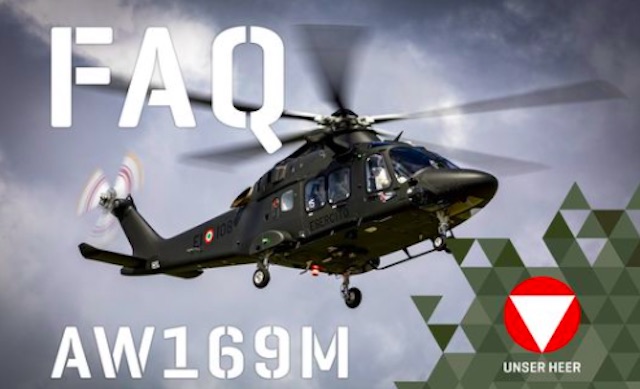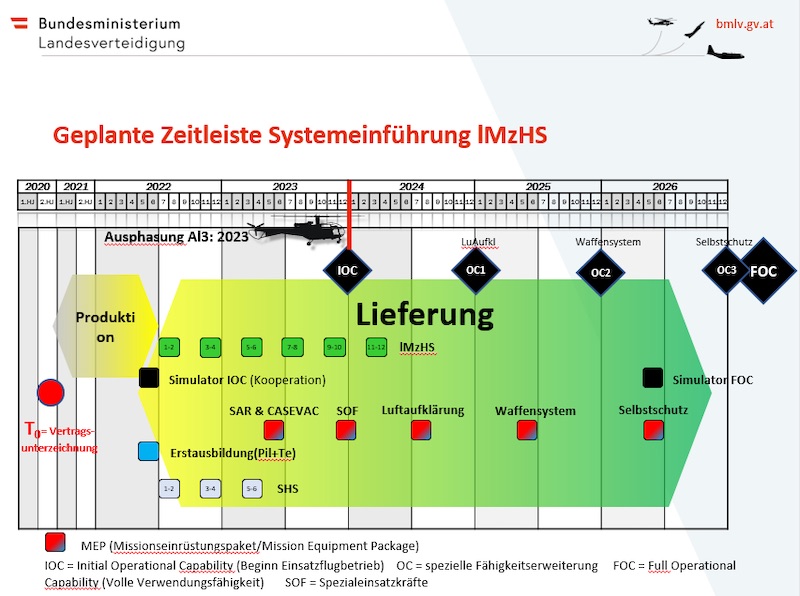Get the weekly SPARTANAT newsletter.
Your bonus: the free E-Book from SPARTANAT.

All details about Leonardo AW169M for the Bundesheer
The Austrian Ministry of Defense is procuring 18 Leonardo AW169M helicopters in a joint cooperation with Italy for around 300 million euros. This decision addresses various questions regarding the procurement, cooperation with Italy, added value for the Austrian economy, selection process, and replacement of existing models.
The Ministry of Defense went shopping and will buy 18 pieces of the Leonardo AW169M in a joint procurement cooperation with Italy for around 300 million euros – we reported. Here are all the answers to questions regarding the procurement cooperation with Italy:
1. What is the procurement volume?
The investment volume for the helicopter procurement is approximately €300 million. This sum covers the entirety of the procurement – helicopters, technology, logistics, as well as training and infrastructure requirements.
2. How much does a helicopter cost in procurement?
A helicopter of this type costs between €8 and 15 million in procurement, depending on the equipment and additional packages.
3. How many helicopters are being procured?
The procurement of 18 pieces is planned in order to have enough helicopters available at all times to handle tasks. Maintenance and training must also be taken into account.
4. What about the value added for the Austrian economy?
There are already several companies in Austria that work as suppliers for the Leonardo group. During further negotiations with the Italian government, special emphasis is placed by the Austrian Ministry of Defense, with the support of the Chamber of Commerce, on Austrian added value (for example, equipment with medical devices, etc.).
5. Why was the decision made on the most expensive helicopter?
For a specific comparison, not only the price but also the capabilities (performance, speed, suitability in high alpine terrain, seating, payload, avionics equipment, etc.) of a helicopter must be taken into account. Helicopters of this size fall within the same price range. For example, the Norwegian police procured helicopters after the AW169 emerged as the best bidder and the Airbus H-145 was unsuccessful.
6. Why was there no tendering process?
The Ministry of Defense was looking for a partner with whom a cooperation in all areas is possible in order to work in a cost-optimized manner over the entire lifecycle of a system. Cooperation with partner nations cannot be established through a tendering process, such as joint use of simulators, optimized storage, modifications in the lifecycle, etc.
7. Why was this model selected?
The cooperation is crucial. The Ministry of Defense has found a partner in Italy who is willing to cooperate in all areas of military helicopter operations with the Austrian Armed Forces. Since Italy will procure up to 100 AW169s, which also meet Austrian requirements (40 helicopters have already been contractually agreed upon and some have already been delivered), this helicopter will be procured as part of a comprehensive cooperation.
8. Why not the USA? Why not Germany?
Cooperation in operation, training, and logistics is ruled out with the Bell 429 promoted by the USA, as this helicopter is not operated by the US armed forces. Germany intends to procure around 60 light multi-purpose helicopters, which are expected to arrive starting in October 2024. Since the „Alouette“ III is scheduled to be decommissioned by the end of 2023, this creates a capability gap for the Austrian Armed Forces of several years (the delivery for Austria of this variant is likely not until 2025 and at least 1 year to achieve regular flight operations). In addition, Germany plans to rely on its own industry for logistics support, which complicates or makes cooperation impossible.
9. Are there already experiences with this company?
The Austrian Armed Forces operate the AB-212, which was manufactured by Leonardo Helicopter (formerly Agusta Westland). The AB-204 and AB-206, which were operated by or are being operated by the Armed Forces, also come from this production. The radar systems for airspace surveillance and military airfields are also products of the Leonardo group.
10. Is the helicopter capable of night flights?
Yes.
11. When will the first helicopter land in Austria?
After the conclusion of contract negotiations (approximately six months), the production of the helicopters (approximately 18 months) will begin. Therefore, the first helicopter is expected to be delivered around mid-2022.
 12. What is the planned timeline; from now until the landing of the first and last helicopters?
12. What is the planned timeline; from now until the landing of the first and last helicopters?
See infographic.
13. Where will the helicopters be stationed?
12 helicopters will be stationed as operational helicopters in Aigen/Ennstal, while six will be stationed as training helicopters in Langenlebarn.
14. Can the existing infrastructure be used or are additional measures and costs involved?
The parking and maintenance can be done in the available hangars at the respective military air bases. Adjustments in terms of power supply, storage, military security measures will be necessary. Regarding simulators, any necessary requirements will only arise after coordination with the cooperation partner, which will then be realized.
15. What does the aircraft decision mean for pilots/technicians?
An initial package of training for pilots and technicians will be considered during the contract negotiations. These will most likely take place at the cooperation partner who already operates the AW169M. Future training will then be conducted by the Austrian Armed Forces themselves.
16. Can this helicopter perform all the tasks that the „Alouette“ III could?
The AW169M can perform all the tasks that the „Alouette“ III could and will be able to do even more. This includes a higher transport capacity in the cabin, the ability to transport heavier external loads, and the ability to fly under instrument flight conditions.
17. Which other nations have already introduced this helicopter in the military? What experiences have emerged from this?
Italy. There is the possibility of comprehensive cooperation with an EU partner that borders Austria.
18. Are there already other organizations in Austria or neighboring countries that use this type?
The Swiss air rescue organization REGA has procured AW169M helicopters, which will be delivered there shortly. In addition, more than 100 AW169s have already been delivered, of which half are used in emergency medical services.
19. Can this helicopter be used for wildfires?
Yes. Here, there is also a higher transport capacity compared to the „Alouette“ III. The AW169M can carry three times the amount of extinguishing water compared to the „Alouette“ III, which could carry 500 liters
20. Are there offset agreements related to the procurement of this helicopter?
No.
21. Can the helicopter be armed?
Yes, there are various mission equipment packages with which the helicopter can be equipped for various tasks.
22. What is the planned service life?
At least 30 years.
23. Which helicopters will the AW169M replace?
It replaces the „Alouette“ III, which is at the end of its technical life after 50 years. All other models will continue to fly.
24. Which helicopter type will be replaced next?
The ten OH-58 helicopters can still be operated until 2030 and will need to be replaced at that time.
25. Allegedly, this helicopter has a very strong „Downwash.“
The helicopter has a similar "Downwash" to an H-145 or a Bell 429, because the rotor disc area is larger and therefore, despite the higher weight, a comparable air throughput (= "Downwash") is generated.
26. It is said that this helicopter is called a "paper helicopter"?
The definition of a paper helicopter is not known. The fact is that more than 100 AW169s have already been delivered and the Italian Armed Forces have already procured around 40 units (22 for the Guardia di Finanza, 15 for the Army), and more helicopters (total of around 100) will be procured.
27. Isn't it too big as a training helicopter?
The advantage of using an identical helicopter for operations and training is based on the fact that most of the training is already conducted on the training helicopter, and no retraining is required for the operational helicopter. In addition, training tasks currently assigned to operational squads can also be performed by the training helicopters, relieving operational squads. This leads to a higher availability of helicopters for fulfilling operational tasks. The AW169 is also used as a training helicopter in Italy.
28. There was a crash of this helicopter in England due to a technical defect in the tail rotor. Has this problem been resolved?
To our knowledge, this was a one-off error with the affected helicopter, which has no impact on the rest of the fleet. However, the manufacturer constantly evaluates its systems and carries out appropriate modifications to the helicopters as needed.
29. How many people can be transported with it?
Up to ten passengers can be transported.
30. What armament will the helicopter receive?
The weapons system should consist of the following components according to the military specification: onboard cannon (12.7mm or 2cm), guided or unguided rockets, ideally a laser-guided missile, a FLIR that can be used for both air reconnaissance tasks and for precise weapons usage, and an integrated weapon computer with sighting capability inside the helicopter. The weapons should be mounted on a rack that can be installed and removed in the helicopter within a few hours. The exact specifications are still to be negotiated in detail with the partner.
31. Are the lifecycle costs significantly higher than those of other models?
The currently reported operating costs (Bell approx. €800, H-145 approx. €1,000, AW169 approx. €1,300) in the media come from a civilian database (Conklin & deDecker) used in civil aviation, and refer to the respective civilian version of the helicopter types. However, no relation to the sizes and capabilities of the helicopters was established here (number of passengers, weight of an external load, etc.)
When comparing a VW Passat with a VW Multivan, there are differences, but they also have different capabilities. The procurement costs for the H-145M and the AW169M appear to be in a similar class. For example, the Norwegian police procured 3 helicopters with mission equipment (FLIR) and the AW169 won against the H-145.
The mentioned operating costs are also to be evaluated in the sense that the AW169 has only been on the market since 2015 and compared to other models, the numbers are subject to greater variability. The more comprehensive a cooperation can be developed with a partner, the more the costs per flight hour can be reduced.
32. When will the new three "Black Hawks" arrive?
According to the contract, the first of the three additional "Black Hawks" is expected to be delivered in autumn 2021, with the others expected in 2022. Delays due to Covid-19 restrictions cannot be ruled out at this time.
33. Where will the type factory be stationed?
The type factory is planned to be stationed in the area of Fliegerwerft 3 with the location in Aigen/Ennstal.
HERE is the Leonardo fact sheet on the AW196M.
LEONARDO on the Internet: www.leonardocompany.com
SPARTANAT is the online magazine for Military News, Tactical Life, Gear & Reviews.
Send us your news: [email protected]
Ad
similar
Get the weekly SPARTANAT newsletter.
Your bonus: the free E-Book from SPARTANAT.


